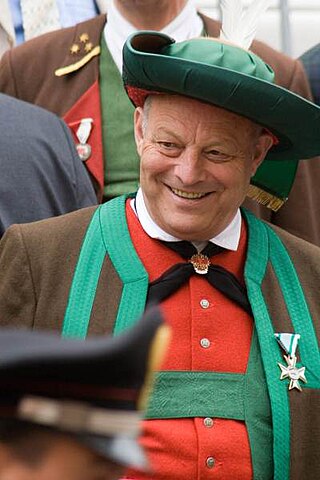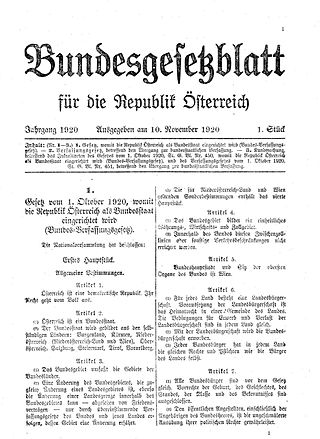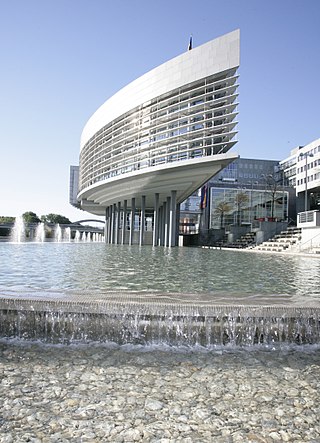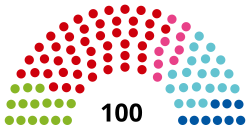
The Federal Council is the upper house of the Austrian Parliament, representing the nine States of Austria at the federal level. As part of a bicameral legislature alongside of the National Council, it can be compared with an upper house or a senate. In fact, however, it is far less powerful than the National Council: although it has to approve every new law decided for by this lower chamber, the latter can—in most cases—overrule the Federal Council's refusal to approve.

Cisleithania, officially The Kingdoms and Lands Represented in the Imperial Council, was the northern and western part of Austria-Hungary, the Dual Monarchy created in the Compromise of 1867—as distinguished from Transleithania. This name for the region was a common, but unofficial one.

The Greens – The Green Alternative is a green political party in Austria.

A Landtag is generally the legislative assembly or parliament of a federated state or other subnational self-governing entity in German-speaking nations. It is usually a unicameral assembly exercising legislative competence in non-federal matters.

The Constitution of Austria is the body of all constitutional law of the Republic of Austria on the federal level. It is split up over many different acts. Its centerpiece is the Federal Constitutional Law (Bundes-Verfassungsgesetz) (B-VG), which includes the most important federal constitutional provisions.

Landeshauptmann or Landeshauptfrau is the chairman of a state government and the supreme official of an Austrian state and the Italian autonomous provinces of South Tyrol and Trentino. His or her function is equivalent to that of a minister-president or premier. Until 1933 the term was used in Prussia for the head of government of a province, in the modern-day states of Germany the counterpart to Landeshauptmann is the Ministerpräsident (minister-president).

The Austrian Parliament Building in Vienna is where the two houses of the Austrian Parliament conduct their sessions. The building is located on the Ringstraße boulevard in the first district Innere Stadt, near Hofburg Palace and the Palace of Justice. It was built to house the two chambers of the Imperial Council (Reichsrat), the bicameral legislature of the Cisleithanian (Austrian) part of the Austro-Hungarian Empire. Since its construction, the Parliament Building has been the seat of these two houses, and their successors—the National Council (Nationalrat) and the Federal Council (Bundesrat)—of the Austrian legislature.

Vienna City Hall is the seat of local government of Vienna, located on Rathausplatz in the Innere Stadt district. Constructed from 1872 to 1883 in a Neo-Gothic style according to plans designed by Friedrich von Schmidt, it houses the office of the Mayor of Vienna as well as the chambers of the city council and Vienna Landtag diet. For a brief period between 1892 and 1894, the Vienna City Hall was the world's tallest building, until it was eclipsed by Milwaukee City Hall.

Red Vienna was the colloquial name for the capital of Austria between 1918 and 1934, when the Social Democratic Workers' Party of Austria (SDAP) maintained almost unilateral political control over Vienna and, for a short time, Austria as a whole. During this time, the SDAP pursued a rigorous program of construction projects across the city in response to severe housing shortages and implemented policies to improve public education, healthcare, and sanitation.

The Constitutional Court in Austria is the tribunal responsible for judicial review.

The Wienbibliothek im Rathaus, formerly known as the Wiener Stadt- und Landesbibliothek, is a library and archive containing important documents related to the history of Vienna, Austria. Founded in 1856, the library, which also contains a large collection of local memorabilia, is located in the Rathaus in the Innere Stadt first district of the city, and is the official library of the city and state of Vienna.

The 2005 Viennese state election was held on 23 October 2005 to elect the members of the Gemeinderat and Landtag of Vienna.

The Federal Constitutional Law is a federal constitutional law in Austria serving as the centerpiece of the Constitution. It establishes Austria as a democratic federal parliamentary republic.

The following outline is provided as an overview of and topical guide to Vienna:

The Landtag of Lower Austria is the state parliament of the Austrian state of Lower Austria. It exercises the state legislation (legislature). The seat of the Landtag is in St. Pölten in the Landhausviertel.

Michael Ludwig is an Austrian politician of the Social Democratic Party (SPÖ). Since May 2018, he has been Mayor and Governor of Vienna, the capital and largest city of Austria. Since January 2018, he has also served as chairman of SPÖ Vienna. Prior, he was City Councillor for Housing, Construction, and Urban Renewal from January 2007 until his election as mayor. He was also Second Deputy Mayor and Governor of Vienna from March 2009 to October 2010.

The 2015 Viennese state election was held on 11 October 2015 to elect the members of the Gemeinderat and Landtag of Vienna.

The 2020 Viennese state election was held on 11 October 2020 to elect the members of the Gemeinderat and Landtag of Vienna. The outgoing government was a coalition of the Social Democratic Party (SPÖ) and The Greens.

Dominik Nepp is an Austrian politician who has been leader of the Freedom Party (FPÖ) in Vienna since 2019. He has been non-executive deputy Mayor and city councillor in the government of Vienna since 2017.

Christoph Wiederkehr is an Austrian politician of NEOS – The New Austria. Since November 2020, he has served as Vice Mayor of Vienna and City Councillor for Education. He is leader of the Viennese branch of NEOS, and was previously leader of the party's parliamentary group in the Gemeinderat and Landtag of Vienna since September 2018.





















